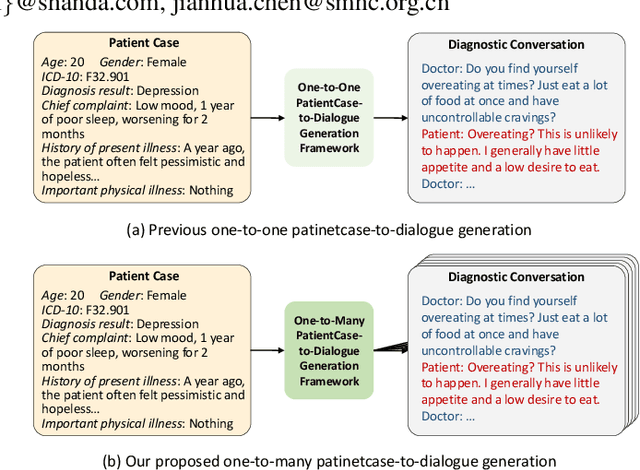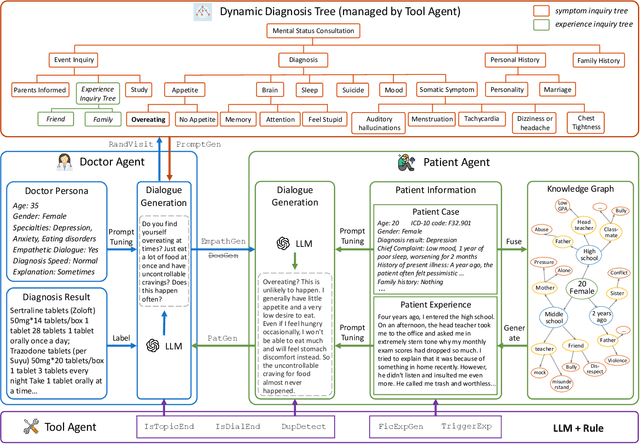Piji Li
Generating Diverse Training Samples for Relation Extraction with Large Language Models
May 29, 2025Abstract:Using Large Language Models (LLMs) to generate training data can potentially be a preferable way to improve zero or few-shot NLP tasks. However, many problems remain to be investigated for this direction. For the task of Relation Extraction (RE), we find that samples generated by directly prompting LLMs may easily have high structural similarities with each other. They tend to use a limited variety of phrasing while expressing the relation between a pair of entities. Therefore, in this paper, we study how to effectively improve the diversity of the training samples generated with LLMs for RE, while also maintaining their correctness. We first try to make the LLMs produce dissimilar samples by directly giving instructions in In-Context Learning (ICL) prompts. Then, we propose an approach to fine-tune LLMs for diversity training sample generation through Direct Preference Optimization (DPO). Our experiments on commonly used RE datasets show that both attempts can improve the quality of the generated training data. We also find that comparing with directly performing RE with an LLM, training a non-LLM RE model with its generated samples may lead to better performance.
Improving Brain-to-Image Reconstruction via Fine-Grained Text Bridging
May 29, 2025Abstract:Brain-to-Image reconstruction aims to recover visual stimuli perceived by humans from brain activity. However, the reconstructed visual stimuli often missing details and semantic inconsistencies, which may be attributed to insufficient semantic information. To address this issue, we propose an approach named Fine-grained Brain-to-Image reconstruction (FgB2I), which employs fine-grained text as bridge to improve image reconstruction. FgB2I comprises three key stages: detail enhancement, decoding fine-grained text descriptions, and text-bridged brain-to-image reconstruction. In the detail-enhancement stage, we leverage large vision-language models to generate fine-grained captions for visual stimuli and experimentally validate its importance. We propose three reward metrics (object accuracy, text-image semantic similarity, and image-image semantic similarity) to guide the language model in decoding fine-grained text descriptions from fMRI signals. The fine-grained text descriptions can be integrated into existing reconstruction methods to achieve fine-grained Brain-to-Image reconstruction.
Improve Language Model and Brain Alignment via Associative Memory
May 20, 2025Abstract:Associative memory engages in the integration of relevant information for comprehension in the human cognition system. In this work, we seek to improve alignment between language models and human brain while processing speech information by integrating associative memory. After verifying the alignment between language model and brain by mapping language model activations to brain activity, the original text stimuli expanded with simulated associative memory are regarded as input to computational language models. We find the alignment between language model and brain is improved in brain regions closely related to associative memory processing. We also demonstrate large language models after specific supervised fine-tuning better align with brain response, by building the \textit{Association} dataset containing 1000 samples of stories, with instructions encouraging associative memory as input and associated content as output.
DBudgetKV: Dynamic Budget in KV Cache Compression for Ensuring Optimal Performance
Feb 24, 2025Abstract:To alleviate memory burden during inference of large language models (LLMs), numerous studies have focused on compressing the KV cache by exploring aspects such as attention sparsity. However, these techniques often require a pre-defined cache budget; as the optimal budget varies with different input lengths and task types, it limits their practical deployment accepting open-domain instructions. To address this limitation, we propose a new KV cache compression objective: to always ensure the full-cache performance regardless of specific inputs, while maximizing KV cache pruning as much as possible. To achieve this goal, we introduce a novel KV cache compression method dubbed DBudgetKV, which features an attention-based metric to signal when the remaining KV cache is unlikely to match the full-cache performance, then halting the pruning process. Empirical evaluation spanning diverse context lengths, task types, and model sizes suggests that our method achieves lossless KV pruning effectively and robustly, exceeding 25% compression ratio on average. Furthermore, our method is easy to integrate within LLM inference, not only optimizing memory space, but also showing reduced inference time compared to existing methods.
Generative Visual Commonsense Answering and Explaining with Generative Scene Graph Constructing
Jan 15, 2025Abstract:Visual Commonsense Reasoning, which is regarded as one challenging task to pursue advanced visual scene comprehension, has been used to diagnose the reasoning ability of AI systems. However, reliable reasoning requires a good grasp of the scene's details. Existing work fails to effectively exploit the real-world object relationship information present within the scene, and instead overly relies on knowledge from training memory. Based on these observations, we propose a novel scene-graph-enhanced visual commonsense reasoning generation method named \textit{\textbf{G2}}, which first utilizes the image patches and LLMs to construct a location-free scene graph, and then answer and explain based on the scene graph's information. We also propose automatic scene graph filtering and selection strategies to absorb valuable scene graph information during training. Extensive experiments are conducted on the tasks and datasets of scene graph constructing and visual commonsense answering and explaining, respectively. Experimental results and ablation analysis demonstrate the effectiveness of our proposed framework.
Decoding the Echoes of Vision from fMRI: Memory Disentangling for Past Semantic Information
Sep 30, 2024



Abstract:The human visual system is capable of processing continuous streams of visual information, but how the brain encodes and retrieves recent visual memories during continuous visual processing remains unexplored. This study investigates the capacity of working memory to retain past information under continuous visual stimuli. And then we propose a new task Memory Disentangling, which aims to extract and decode past information from fMRI signals. To address the issue of interference from past memory information, we design a disentangled contrastive learning method inspired by the phenomenon of proactive interference. This method separates the information between adjacent fMRI signals into current and past components and decodes them into image descriptions. Experimental results demonstrate that this method effectively disentangles the information within fMRI signals. This research could advance brain-computer interfaces and mitigate the problem of low temporal resolution in fMRI.
HELPD: Mitigating Hallucination of LVLMs by Hierarchical Feedback Learning with Vision-enhanced Penalty Decoding
Sep 30, 2024



Abstract:Large Vision-Language Models (LVLMs) have shown remarkable performance on many visual-language tasks. However, these models still suffer from multimodal hallucination, which means the generation of objects or content that violates the images. Many existing work detects hallucination by directly judging whether an object exists in an image, overlooking the association between the object and semantics. To address this issue, we propose Hierarchical Feedback Learning with Vision-enhanced Penalty Decoding (HELPD). This framework incorporates hallucination feedback at both object and sentence semantic levels. Remarkably, even with a marginal degree of training, this approach can alleviate over 15% of hallucination. Simultaneously, HELPD penalizes the output logits according to the image attention window to avoid being overly affected by generated text. HELPD can be seamlessly integrated with any LVLMs. Our experiments demonstrate that the proposed framework yields favorable results across multiple hallucination benchmarks. It effectively mitigates hallucination for different LVLMs and concurrently improves their text generation quality.
MDD-5k: A New Diagnostic Conversation Dataset for Mental Disorders Synthesized via Neuro-Symbolic LLM Agents
Aug 22, 2024



Abstract:The clinical diagnosis of most mental disorders primarily relies on the conversations between psychiatrist and patient. The creation of such diagnostic conversation datasets is promising to boost the AI mental healthcare community. However, directly collecting the conversations in real diagnosis scenarios is near impossible due to stringent privacy and ethical considerations. To address this issue, we seek to synthesize diagnostic conversation by exploiting anonymous patient cases that are easier to access. Specifically, we design a neuro-symbolic multi-agent framework for synthesizing the diagnostic conversation of mental disorders with large language models. It takes patient case as input and is capable of generating multiple diverse conversations with one single patient case. The framework basically involves the interaction between a doctor agent and a patient agent, and achieves text generation under symbolic control via a dynamic diagnosis tree from a tool agent. By applying the proposed framework, we develop the largest Chinese mental disorders diagnosis dataset MDD-5k, which is built upon 1000 cleaned real patient cases by cooperating with a pioneering psychiatric hospital, and contains 5000 high-quality long conversations with diagnosis results as labels. To the best of our knowledge, it's also the first labelled Chinese mental disorders diagnosis dataset. Human evaluation demonstrates the proposed MDD-5k dataset successfully simulates human-like diagnostic process of mental disorders. The dataset and code will become publicly accessible in https://github.com/lemonsis/MDD-5k.
LEMoE: Advanced Mixture of Experts Adaptor for Lifelong Model Editing of Large Language Models
Jun 28, 2024Abstract:Large language models (LLMs) require continual knowledge updates to stay abreast of the ever-changing world facts, prompting the formulation of lifelong model editing task. While recent years have witnessed the development of various techniques for single and batch editing, these methods either fail to apply or perform sub-optimally when faced with lifelong editing. In this paper, we introduce LEMoE, an advanced Mixture of Experts (MoE) adaptor for lifelong model editing. We first analyze the factors influencing the effectiveness of conventional MoE adaptor in lifelong editing, including catastrophic forgetting, inconsistent routing and order sensitivity. Based on these insights, we propose a tailored module insertion method to achieve lifelong editing, incorporating a novel KV anchor routing to enhance routing consistency between training and inference stage, along with a concise yet effective clustering-based editing order planning. Experimental results demonstrate the effectiveness of our method in lifelong editing, surpassing previous model editing techniques while maintaining outstanding performance in batch editing task. Our code will be available.
MEMoE: Enhancing Model Editing with Mixture of Experts Adaptors
May 29, 2024Abstract:Model editing aims to efficiently alter the behavior of Large Language Models (LLMs) within a desired scope, while ensuring no adverse impact on other inputs. Recent years have witnessed various model editing methods been proposed. However, these methods either exhibit poor overall performance or struggle to strike a balance between generalization and locality. We propose MOMoE, a model editing adapter utilizing a Mixture of Experts (MoE) architecture with a knowledge anchor routing strategy. MOMoE updates knowledge using a bypass MoE structure, keeping the original parameters unchanged to preserve the general ability of LLMs. And, the knowledge anchor routing ensures that inputs requiring similar knowledge are routed to the same expert, thereby enhancing the generalization of the updated knowledge. Experimental results show the superiority of our approach over both batch editing and sequential batch editing tasks, exhibiting exceptional overall performance alongside outstanding balance between generalization and locality. Our code will be available.
 Add to Chrome
Add to Chrome Add to Firefox
Add to Firefox Add to Edge
Add to Edge